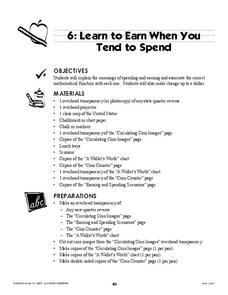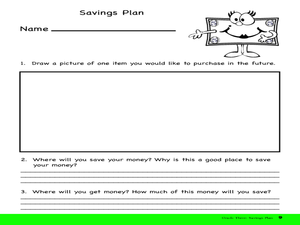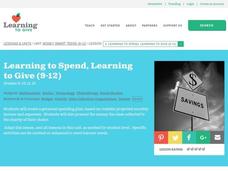Visa
Money Matters: Why It Pays to Be Financially Responsible
What does it mean to be financially responsible? Pupils begin to develop the building blocks of strong financial decision making by reviewing how their past purchases are examples of cost comparing, cost-benefit analysis, and budgeting.
Radford University
Surviving the Month
Pupils create budgets based upon family expenditures. They determine what the monthly payments will be for buying a car and a house based on compound interest for the total amount.
Visa
A Plan for the Future: Making a Budget
From fixed and variable expenses to gross income and net pay, break down the key terms of budgeting with your young adults and help them develop their own plans for spending and saving.
Visa
Making Spending Decisions
By role playing real-world experiences, such as purchasing snacks and grocery/toy store shopping, your youngsters will begin to develop an understanding of how to make decisions and choose between alternatives. This is the first...
Visa
Allowances and Spending Plans
Help youngsters understand how to manage small amounts of money by discussing an allowance and the difference between spending, saving, and giving.
Federal Reserve Bank
Bunny Money
Teach your class about saving, spending, and goal setting with a story about a couple of bunnies who went shopping and related activities. Learners keep track of the bunnies' spending, practice identifying long- and short-term savings...
Federal Reserve Bank
Glo Goes Shopping
Making decisions can be very difficult. Show your class one way to evaluate choices with this lesson, which is inspired by the book Glo Goes Shopping. Learners practicing using a decision-making grid with the content of the story and a...
Visa
Money Responsibility
Introduce young learners to the important life skill of responsibly managing money and recording how much they spend and save.
Curated OER
Learn to Earn When you Tend to Spend
Analyzing and understanding word problems is extremely important. Pupils learn that in money problems, earn usually means you add and spend usually means you subtract. They will solve a series of money-related word problems, label coins,...
Curated OER
Consumer Borrowing and Spending
Credit can be confusing for teens, some of whom are already using credit cards. Clear up misconceptions with this group research activity which has a solid outline with a lot of room to adjust to your needs and resources. Groups are...
Curated OER
What Can You Do With Money?
Students watch a Biz Kidz video about money, learn what they can do with money, and fill out worksheets on what they learn. Students learn about spending, saving, donating, and investing.
Curated OER
Children's Literature Across the Curriculum Ideas-If You Made A Million
Students read If You Made A Million by David M. Schwartz. They complete a variety of cross-curricular activities surrounding the study of earning, saving and spending money. Included are reading, art, math, science, writing, social...
Curated OER
Money, Money, Honey Bunny!
Students read a story about spending and saving money and talk about the difference between goods and services. For this money lesson plan, students also play a matching game to review the story and practice rhyming words from the story.
Curated OER
Meet Molly An American Girl
Learners examine concepts of personal finance. In this personal finance lesson plan, students use Valerie Tripp's, Meet Molly, An American Girl, to learn about saving and spending after World War II. They compare financial decisions...
Curated OER
Having a Savings Plan
Students discover the importance of saving and spending. In this finance lesson, students read the book Kermit the Hermit and discuss the differences between needs and wants. The students complete worksheets concerning money in their...
Curated OER
Thinking About Money
Students evaluate various approaches to spending money.In this spending money literacy lesson, students broaden their financial goals by reading "Alexander Who Used to Be Rich Last Sunday" and "A Chair for My Mother."Students use a Venn...
Curated OER
Tarantula Shoes
High schoolers read a book about Ryan O'Keefe, a young man who wants a pair of basketball shoes promoted by a basketball star. They explore about spending, saving, opportunity cost, and trade-offs as they study Ryan's decisions...
Curated OER
Family Money Matters: Exploring the World of Economics
Students become familiar with vocabulary related to spending money. In this economics instructional activity, students participate in activities to learn about spending money and budgets.
Curated OER
A Family Spending Plan
Students investigate family expenditures. In this family budget lesson, students examine the wages and expenditures of family and then create a monthly budget for the family to follow.
Curated OER
Money, Money, Honey Bunny!
Learners determine the differences between goods and services, and saving and spending. In this economics lesson, students listen to a rhyming story about a bunny with money. They play a matching game with the associated cards and work...
Curated OER
Learning to Spend, Learning to Give
Students explore the concept of personal finances. In this personal finances instructional activity, students identify their income and expenses. Students create a budget for their spending, saving, investing, and donating habits....
Curated OER
How You Use Credit Cards Should Determine How You Choose Them
Students explore the concept of credit cards. For this credit cards lesson, students read an article about credit card spending. Students discuss different ways in which people use credit cards. Students determine what kind of spender...
Curated OER
Consumerism Scavenger Hunt
Students explore consumerism. In this economics activity, students work with a partner to complete an Internet Research consumer scavenger hunt. Students discuss information collected and conflicting answers to various questions.
Curated OER
Spending
Students participate in a lesson that illustrates the concept of spending and how it effects the economy. Technology is integrated in this study with the use of a computer simulation of a pinball game that shows how fast money can be spent.

























